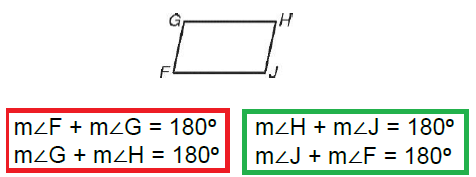FINDING MISSING ANGLES OF PARALLELOGRAM
Subscribe to our ▶️ YouTube channel 🔴 for the latest videos, updates, and tips.
Consecutive Angles in Parallelogram

Opposite Angles in Parallelogram

Problem 1 :
From the parallelogram given below, find the value of x, y and z.

Solution :
In triangle EBC.
∠EBC + ∠BCE + ∠CEB = 180
x + 50 + 90 = 180
x + 140 = 180
x = 180 - 140
x = 40
Opposite angles are equal, x = z = 40
In triangle FDC.
∠FDC + ∠DCF + ∠CFD = 180
z + ∠DCF + 90 = 180
40 + 90 + ∠DCF = 180
130 + ∠DCF = 180
∠DCF = 180 - 130
∠DCF = 50
z + ∠DCF + y + 50 = 180
40 + 50 + y + 50 = 180
140 + y = 180
y = 180 - 140
y = 40
Problem 2 :
If one angle of a parallelogram is 24 degree less than twice the smallest angle then, find the largest angle of the parallelogram.
Solution :
Let the smallest angle be x
Larger angle measure = 2x - 24
Sum of consecutive angles = 180
x + 2x - 24 = 180
3x - 24 = 180
3x = 180 + 24
3x = 204
x = 204/3
x = 68
The largest angle measure = 2(68) - 24
= 136 - 24
= 112
So, the largest angle measure is 112.
Problem 3 :
In a parallelogram PQRS, if
∠P = (3x − 5)° and ∠Q = (2x + 15)°
then find the value of x.
Solution :
Since ∠P and ∠Q are consecutive integers, sum of the consecutive integers = 180.
∠P + ∠Q = (3x − 5) + (2x + 15)
3x + 2x - 5 + 15 = 180
5x + 10 = 180
5x = 170
x = 170/5
x = 34
Problem 4 :
If PQRS is a parallelogram, then ∠P − ∠R is
(a) 90° (b) 45° (c) 60° (d) 0°
Solution :
In any parallelogram, the opposite angles will be equal.
∠P = ∠R
∠P − ∠R = 0
Problem 5 :
Two adjacent angles of a parallelogram are 3x - 4 and 3x + 10. Find the angles of parallelogram.
Solution :
Adjacent angles are 3x - 4 and 3x + 10.
Sum of adjacent angles (Consecutive angles) = 180
3x - 4 + 3x + 10 = 180
6x + 6 = 180
6x = 180 - 6
6x = 174
x = 174/6
x = 29
|
3x - 4 = 3(29) - 4 = 87 - 4 = 83 |
3x + 10 = 3(29) + 10 = 87 + 10 = 97 |
So, the angles are 83 and 97.
Problem 6 :
One angle of a parallelogram is 60 degree. Find its opposite angle and the adjacent angle.
Solution :
Sum of adjacent angels = 180
One of the angle = 60
Adjacent angle = 180 - 60
= 120
In parallelogram, opposite angle will be equal. Opposite angle 60 degree is also 60 degree.
Subscribe to our ▶️ YouTube channel 🔴 for the latest videos, updates, and tips.
Recent Articles
-
Finding Range of Values Inequality Problems
May 21, 24 08:51 PM
Finding Range of Values Inequality Problems -
Solving Two Step Inequality Word Problems
May 21, 24 08:51 AM
Solving Two Step Inequality Word Problems -
Exponential Function Context and Data Modeling
May 20, 24 10:45 PM
Exponential Function Context and Data Modeling